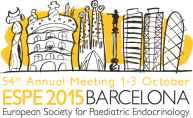
54th Annual ESPE
Barcelona,
Spain
01 Oct 2015 - 03 Oct 2015
Poster Category 2
Hypo
hrp0084p2-484 | Hypo | ESPE2015
Challenged Diagnosis on Hypoglycaemia: Hirata Disease X Factitious Hypoglycaemia
dos Santos Tiago Jeronimo , Passone Caroline , Ito Simone , Savoldelli Roberta , Kuperman Hilton , Filho Hamilton Cabral de Menezes , Steinmetz Leandra , Dichtchekenian Vae , Manna Thais Della , Damiani Durval
hrp0084p2-485 | Hypo | ESPE2015
Is Bedside Monitoring of Blood Beta-Hydroxybutyrate Levels Reliable in the Management of Hypoglycaemia in Children?
Phanse Supriya , Collingwood Catherine , Alsaffar Hussain , Didi Mohammed , Senniappan Senthil
hrp0084p2-486 | Hypo | ESPE2015
Transient Hyperinsulinaemic Hypoglycaemia in Association with a Novel ABCC8 Mutation: Expanding the Clinical Phenotypes
Arya Ved Bhushan , Aziz Qadeer , Mohamed Zainaba , Flanagan Sarah E. , Ellard Sian , Ehtisham Sarah , Tinker Andrew , Hussain Khalid
hrp0084p2-487 | Hypo | ESPE2015
Congenital Hyperinsulinism in Ukraine
Globa Eugenia , Zelinska Nataliya , Flanagan Sarah , Ellard Sian , Christesen Henrik
hrp0084p2-488 | Hypo | ESPE2015
Unexplained Altered States of Consciousness in a Girl
Graf Stefanie , Gerster Karine , Kroiss Sabine , Konrad Daniel , Schonle Eugen
hrp0084p2-489 | Hypo | ESPE2015
The Effectiveness of Sirolimus in a Newborn with Hyperinsulinaemic Hypoglycaemia
Haliloglu Belma , Tuzun Heybet , Flanagan Sarah , Kaya Avni , Celik Muhittin
hrp0084p2-490 | Hypo | ESPE2015
Congenital Hyperinsulinism Caused by a Combination of Novel Heterozygous ABCC8 and KCNJ11 Mutations
Rozenkova Klara , Nessa Azizun , Obermannova Barbora , Dusatkova Lenka , Dusatkova Petra , Sumnik Zdenek , Lebl Jan , Hussain Khalid , Pruhova Stepanka
hrp0084p2-491 | Hypo | ESPE2015
Functional Analysis of Novel ABCC8 Mutations Found in Czech Patients with Congenital Hyperinsulinism
Rozenkova Klara , Dusatkova Petra , Dusatkova Lenka , Nessa Azizun , Obermannova Barbora , Kytnarova Jitka , Sumnik Zdenek , Lebl Jan , Hussain Khalid , Pruhova Stepanka
hrp0084p2-492 | Hypo | ESPE2015
Syndromic Hypoketotic, Hypoinsulinemic Hypoglycaemia due to a Mosaic Activating Phosphatidylinositol 3-Kinase Mutation
Kummer Sebastian , Leiter Sarah M , Welters Alena , Barroso Ines , Meissner Thomas , Semple Robert K
hrp0084p2-493 | Hypo | ESPE2015
Long Acting Somatostatin Analogue (Lanreotide) Therapy in Congenital Hyperinsulinism – Pharmacokinetics and Long-Term Follow-Up Study
Shah Pratik , Rahman Sofia , McElroy Sharon , Gilbert Clare , Morgan Kate , Hinchey Louise , Alam Syeda , Senniappan Senthil , Button Roberta , Margetts Rebecca , Levy Hannah , Marti Carles Morte , Lezcano Carles Celma , Santacreu Emma Bascompta , Amin Rakesh , Hussain Khalid
hrp0084p2-494 | Hypo | ESPE2015
Congenital Hyperinsulinism in Association with Poland Syndrome and Chromosome 10p11-p13 Duplication
Giri Dinesh , Hart Rachel , Weerasinghe Kamal , Didi Mo , Senniappan Senthil
hrp0084p2-495 | Hypo | ESPE2015
Rapid Biochemical Evaluation Aids Timely Management of Congenital Hyperinsulinism
Swain Georgia , Park Julie , Stirrup Kelly , Yung Zoe , Senniappan Senthil , Didi Mohammed



